新概念第一册重点语法知识点汇总
新概念英语第一册所有语法点汇总)
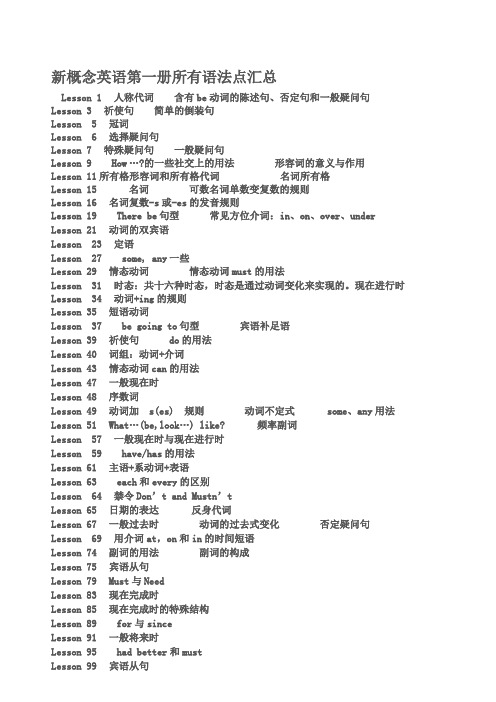
新概念英语第一册所有语法点汇总Lesson 1 人称代词含有be动词的陈述句、否定句和一般疑问句Lesson 3 祈使句简单的倒装句Lesson 5 冠词Lesson 6 选择疑问句Lesson 7 特殊疑问句一般疑问句Lesson 9 How…?的一些社交上的用法形容词的意义与作用Lesson 11所有格形容词和所有格代词名词所有格Lesson 15 名词可数名词单数变复数的规则Lesson 16 名词复数-s或-es的发音规则Lesson 19 There be句型常见方位介词:in、on、over、under Lesson 21 动词的双宾语Lesson 23 定语Lesson 27 some, any一些Lesson 29 情态动词情态动词must的用法Lesson 31 时态:共十六种时态,时态是通过动词变化来实现的。
现在进行时Lesson 34 动词+ing的规则Lesson 35 短语动词Lesson 37 be going to句型宾语补足语Lesson 39 祈使句do的用法Lesson 40 词组:动词+介词Lesson 43 情态动词can的用法Lesson 47 一般现在时Lesson 48 序数词Lesson 49 动词加s(es) 规则动词不定式some、any用法Lesson 51 What…(be,look…) like? 频率副词Lesson 57 一般现在时与现在进行时Lesson 59 have/has的用法Lesson 61 主语+系动词+表语Lesson 63 each和every的区别Lesson 64 禁令Don’t and Mustn’tLesson 65 日期的表达反身代词Lesson 67 一般过去时动词的过去式变化否定疑问句Lesson 69 用介词at,on和in的时间短语Lesson 74 副词的用法副词的构成Lesson 75 宾语从句Lesson 79 Must与NeedLesson 83 现在完成时Lesson 85 现在完成时的特殊结构Lesson 89 for与sinceLesson 91 一般将来时Lesson 95 had better和mustLesson 99 宾语从句Lesson 100 直接引语和间接引语Lesson 101 反意疑问句Lesson 103 too与enough的用法Lesson 105 动词不定式Lesson 107 形容词的比较级和最高级Lesson 111 形容词的平级比较级Lesson 113 so与neither引导的简短回答Lesson 116 不定代词Lesson 117 过去进行时概念和结构Lesson 119 过去完成时Lesson 121 定语从句Lesson 123 感叹句Lesson 125 must, have to和needn’tLesson 127 表示猜测和推断的情态助动词must和can’tLesson 131 情态助动词may表示可能性Lesson 133 需改变时态的间接陈述句Lesson 135 Let的用法Lesson 137 条件从句Lesson 141 被动语态新概念英语第一册语法点归纳大纲新概念英语第一册语法点归纳新概念一共144课,其中单课为课文,双课为语法和练习。
新概念一语法知识汇总

新概念一的语法知识主要包括以下几个方面:
限定词:如some、any、many、much等,用于修饰名词或代词,表示数量或程度的不同。
名词:名词分为可数名词和不可数名词,可数名词有单数和复数形式,不可数名词没有复数形式。
时态变化:包括一般现在时、一般过去时、现在进行时、过去进行时、一般将来时和过去将来时等。
人称变化:根据句意和语境,改变主语和谓语的人称形式。
倒装句:将谓语动词或整个句子放在主语之前,表示强调或按照一定的语法规则进行倒装。
疑问句和否定句:疑问句是将谓语动词提前,否定句是在谓语动词前加上否定词not或don't等。
直接宾语和间接宾语:直接宾语是及物动词的直接对象,间接宾语是及物动词的动作所涉及的人或事务。
介词短语:介词短语是由介词和名词或代词组成的短语,表示某物或某人在某处、某时间的状态或位置。
冠词:冠词用于限定名词,包括不定冠词a/an和定冠词the。
代词:代词用于代替名词或名词短语,避免重复,常见的代词有I、you、he、she、it、they等。
形容词和副词:形容词用于描述名词或代词的特征或属性,副词用于描述动词、形容词或其他副词的形态或程度。
以上是新概念一的主要语法知识汇总,通过学习这些知识,可以帮助学生更好地理解英语的基本结构和表达方式,提高英语水平。
新概念英语第一册各课语法知识汇总
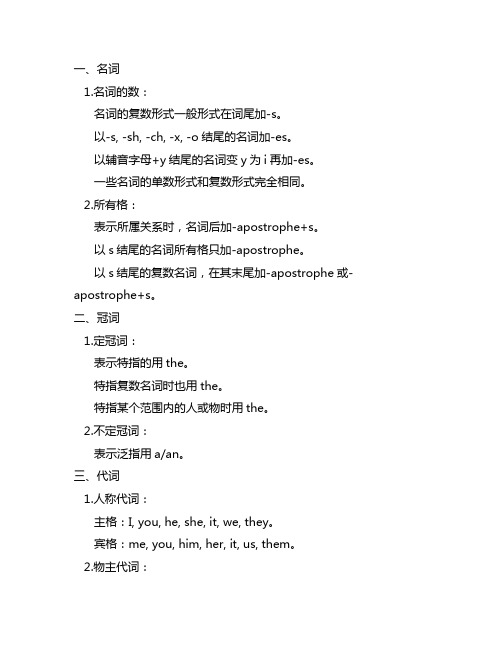
一、名词1.名词的数:名词的复数形式一般形式在词尾加-s。
以-s, -sh, -ch, -x, -o结尾的名词加-es。
以辅音字母+y结尾的名词变y为i再加-es。
一些名词的单数形式和复数形式完全相同。
2.所有格:表示所属关系时,名词后加-apostrophe+s。
以s结尾的名词所有格只加-apostrophe。
以s结尾的复数名词,在其末尾加-apostrophe或-apostrophe+s。
二、冠词1.定冠词:表示特指的用the。
特指复数名词时也用the。
特指某个范围内的人或物时用the。
2.不定冠词:表示泛指用a/an。
三、代词1.人称代词:主格:I, you, he, she, it, we, they。
宾格:me, you, him, her, it, us, them。
2.物主代词:形容词性物主代词:my, your, his, her, its, our, their。
名词性物主代词:mine, yours, his, hers, its, ours, theirs。
3.指示代词:this, that, these, those。
4.不定代词:some, any, no, every, each, many, much, few, little。
四、形容词1.形容词的用法:在名词前作定语。
在系动词之后作表语。
2.比较级和最高级:比较级:比较两者时,用比较级。
最高级:表示三者或三者以上之间的比较。
五、动词1.动词的三单形式:一般情况,动词第三人称单数在末尾加-s。
以辅音字母加y结尾的动词变y为i再加-es。
直接在词尾加-es的动词。
2.动词的现在进行时:am/is/are+动词的现在分词。
3.行为动词的过去式:动词过去式变化规则有规则动词和不规则动词。
六、副词1.副词的用法:修饰动词、形容词、副词。
表示时间、地点、原因、目的等。
2.比较级和最高级:副词比较级和最高级的构成。
七、介词1.介词的基本用法:表示方位、时间、原因、目的等。
新概念第一册知识点整理

Lesson 1-2一、词汇1.指示代词:this that2.Be动词:am is are3.文具类:pen pencil book school teacher4.服饰类:watch dress skirt shirt T-shirt handbag coat cloakroom suit5.其他:excuse pardon thank you thanks house car二、语法:1、指示代词this that 的用法指示代词this that表示“这个”、“那个”。
是指单个的人或物。
this 表示时间和空间上较接近说话人的人或物。
That表示时间和空间上离说话人较远的人或物。
使用this that时注意以下两点:1.1 this that只和单数连用,如This is a dog. That is a pencil.1.2以this that作主语的疑问句,其答语通常用it指代。
如:Is that a cap? Yes, it is.1.3 初次见面介绍某人时常用this. Mum, this is my friend, Mary.1.4打电话时,用this表示“我”,用that表示“你”。
如:Hello, this is Mary, Who’s that? 你好!我是玛丽,你是谁?2、be动词的用法Be动词通常在句中做谓语,基本形式有is/am/are (以下是对应人称代词的固定搭配)I am=I’m You are = You’re He is = He’s She is = She’s It is = It’sWe are = We’re They are = They’re3、陈述句、一般疑问句陈述句:This is your handbag. 陈述句变一般疑问句:Is this your handbag?陈述句变一般疑问句方法四步:3.1 找出陈述句中的助动词,如is am are 3.2 助动词大写提前至句首。
新概念英语第一册语法归纳全篇

可编辑修改精选全文完整版新概念英语第一册语法归纳新概念英语第一册语法归纳《新概念英语》作为一套世界闻名的英语教程,以其全新的教学理念,有趣的课文内容和全面的技能训练,深受广大英语学习者的欢迎和喜爱。
以下店铺为大家整理的新概念英语第一册语法归纳,欢迎阅读!新概念英语第一册语法归纳篇1感叹句感叹句:1)What +名词+主语+谓语What a beautiful girl she is!What tall buildings they are!2)How +形容词+主语+谓语How beautiful the girl is!How tall the buildings are!在口语中,感叹句的主语和谓语常常省略:What a nice present!(省略it is)How disappointed!(省略she is或其它可作本句主、谓的词语) 祈使句祈使句表示请求、命令、建议、邀请等,谓语动词一律用原型,句子中通常不用主语,句末用惊叹好或者句号,用降调。
肯定句:动词原型Come here,please.Go downstairs,please.Stand up.Sit down.Be quiet.Be careful.祈使句中如果有唤语,一定要用逗号隔开,放在句首或者句尾:Come in,Amy.Sit down here,Tom.Mary,give me a book please.否定:Don't+动词原型Don't come here.Don't sit down.Don't stand up.Don't give me it.let sb. do 让某人做Let me pass.Let us have a rest.Let's have a rest.反意疑问:Let's have a walk along the river,shall we?Let us go out for a drink,will you?so/neither的倒装倒装句:so/neither的倒装eg: He can swim. So can I.She didn't go to class. Neither did I.结构:so/neither+be+ 主语so/neither+助动词+ 主语so/neither+情态动词+ 主语助动词:一般现在时: do,does/am,is,are现在进行时: am,is,are一般过去时: did现在完成时: have,has一般将来时: will,shall过去进行时: was,were过去完成时: had过去将来时: would直接引语/间接引语如果引语的主句所用动词为过去时,那么间接引语要做相应变化:时态,人称,时间地点及指示词1)时态变化:一般现在时——一般过去时现在进行时——过去进行时一般过去时——过去完成时现在完成时——过去完成时一般将来时——过去将来时be going to——was/were going to/wouldcan--couldmay--might2)时间地点及指示词的变化:here-there,tomorrow-the next day,the following day,this-that…3)人称变化:根据句意改变人称。
新概念英语第一册重点词汇和语法(完整版)
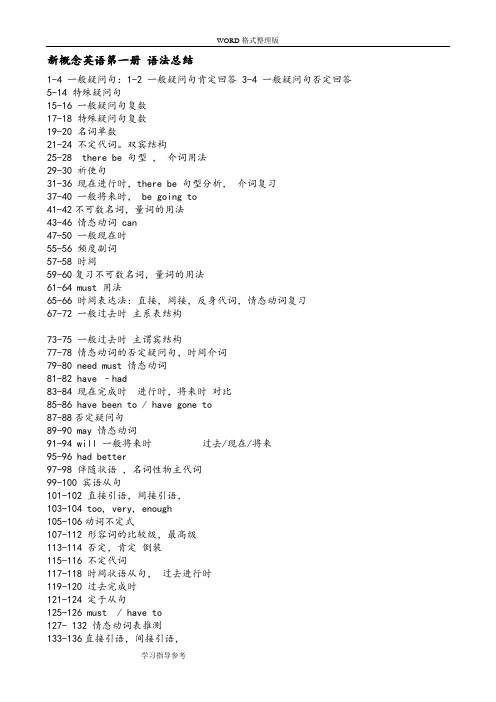
新概念英语第一册语法总结1-4 一般疑问句:1-2 一般疑问句肯定回答 3-4 一般疑问句否定回答5-14 特殊疑问句15-16 一般疑问句复数17-18 特殊疑问句复数19-20 名词单数21-24 不定代词。
双宾结构25-28 there be 句型,介词用法29-30 祈使句31-36 现在进行时,there be 句型分析,介词复习37-40 一般将来时, be going to41-42不可数名词,量词的用法43-46 情态动词 can47-50 一般现在时55-56 频度副词57-58 时间59-60复习不可数名词,量词的用法61-64 must 用法65-66 时间表达法:直接,间接,反身代词,情态动词复习67-72 一般过去时主系表结构73-75 一般过去时主谓宾结构77-78 情态动词的否定疑问句,时间介词79-80 need must 情态动词81-82 have –had83-84 现在完成时进行时,将来时对比85-86 have been to / have gone to87-88否定疑问句89-90 may 情态动词91-94 will 一般将来时过去/现在/将来95-96 had better97-98 伴随状语,名词性物主代词99-100 宾语从句101-102 直接引语,间接引语,103-104 too, very, enough105-106动词不定式107-112 形容词的比较级,最高级113-114 否定,肯定倒装115-116 不定代词117-118 时间状语从句,过去进行时119-120 过去完成时121-124 定于从句125-126 must / have to127- 132 情态动词表推测133-136直接引语,间接引语,137-138 条件状语从句139-140宾语从句141-144 被动语态Lesson 1 Excuse me1. Words1) excuse (1)重音(2)与sorry 的区别(3)Excuse 用的不同场景a. 请别人让路b. 引起别人的注意c. 打断别人的谈话d. 可以当n. 借口 eg. No excuse. 别找借口,没有借口。
新概念英语第一册语法知识点

新概念英语第一册语法总结时态:一般现在时、现在进行时、一般过去时、现在完成时、一般将来时、过去进行时、过去完成时、过去将来时1. 一般现在时..★含有be动词的句子He is a teacher.The girl is very beautiful.Tim and Jack are students.★变疑问句将be动词移到句首Is he a teacherIs the girl very beautifulAre Tim and Jack students★变否定句在be动词后面加notHe is not a teacher.The girl is not very beautiful.Tim and Jack are not students.★肯定回答及否定回答Yes; he is. No; he is not.Yes; she is. No; she is not.Yes; they are. No; they are not.★含有一般动词的句子★第三人称单数及单数名词He likes books.She likes him.The dog likes bones.★变疑问句在句首加does; 动词变为原型Does he like booksDoes she like himDoes the dog like bones★变否定句在主语及动词之间加doesn’t; 动词变为原型He doesn’t like books.She doesn’t like him.The dog doesn’t like bones.★肯定回答及否定回答:Yes; he does. No; he doesn’t.Yes; she does. No; she doesn’tYes; it does. No; it doesn’t.注意:第三人称单数形式一般在动词后面加S..★其他人称及复数名词I want to have a bath.We have some meat.The students like smart teachers.★变疑问句在句首加doDo you want to have a bathDo we have any meatDo the students like smart teachers★变否定句在主语和动词之间加don’t.You don’t want to have a bath.We don’t have any meat.The students don’t like smart teachers.★肯定回答及否定回答Yes; I do. No; I don’t.Yes; we do. No; we don’tYes; they do. No; they don’t...构成:主语+be动词+动词的现在分词+其它成分We are having lunch.He is reading a book.The dog is running after a cat.The boys are swimming across the river.★变疑问句将be动词移到句首Are we having lunchIs he reading a bookIs the dog running after a catAre the boys swimming across the river★变否定句在be动词后面加notWe are not having lunch.He is not reading a book.The dog is not running after a cat.The boys are swimming across the river.★特殊疑问句:what; which; how; where; who; etc. 疑问词+be动词+主语+现在分词What are you doingWhat is she doingWhat is the dog doing没有进行时的动词必背表示状态、思想、感情、感觉的动词不能表示正在进行的动作1. 表示感觉、感官的词see; hear; like; love; want2. have; has作为动词”拥有”的含义时;没有进行时;常和表示过去的时间状语连用;如yesterday; last night; the day before yesterday; three days ago.含有be动词的句子;将动词变为过去式;am / is的变为was;are的变为wereI was at the butcher’s.You were a student a year ago.The teacher was very beautiful ten years ago.★变疑问句将be动词移动到句首Were you at the butcher’sWere you a student a year agoWas the teacher very beautiful ten years ago★变否定句在be动词后面加notI was not at the butcher’s.You were not a student a year ago.The teacher was not very beautiful ten years ago.★肯定回答否定回答Yes; I was. No; I was not.Yes; you were. No; you were not.Yes; he/she was. No; he/she was not.★特殊疑问句:What did you do不含有be动词的句子;将动词变为过去式;动词过去式构成见附录I finished my homework yesterday.The boy went to a restaurant.The Sawyers lived at King Streeta year ago.King Streeta year ago.★变疑问句在句首加did;动词变为原型Did you finish your homework yesterdayDid the boy go to a restaurantDid the Sawyers live at King Streeta year agoKing Streeta year ago★变否定句在主语和动词之间加did not;动词变为原型I did not finish my homework yesterday.The boy did not go to a restaurant.The Sawyers did not live at King Streeta year ago.King Streeta year ago.★肯定回答及否定回答Yes; I did. No; I didn’t.Yes; he did. No; he didn’t.Yes; they did. No; they did not.have/has+过去分词用法:1表示过去发生且和现在有某种联系的动作;常和just; usually; already; since等时间副词连用I have just had lunch. 饱了;不用再吃了He has had a cup of tea.不渴了;不用再喝They have already had their holiday. 不能再度假了The boy has already read the book. 已经知道书的内容了;不用再看了2询问别人是否做过某事一般用现在完成时Have you finished your homeworkHave you been to BeijingHave he seen the film3表示开始于过去并持续到现在的动作I have lived in Beijing for twenty years.I have worked for this school for 1 year.4表示一种经历、经验:去过…地方;做过…事情;经历过…事情I have never had a bath.I have never seen a film.I have never been to cinema.I have ever been to Paris.Have been to表示去过;have gone to 表示去了I have been to London.人已经回来He has gone to London.人还在那里5表示一种结果;一般不和时间副词联用I have lost my pen.I have hurt myself.He has become a teacher.She has broken my heart.句型变化:★变疑问句将助动词移到句首;变否定句在助动词后面加not.Have you lost your pen I have not lost my pen.★肯定回答及否定回答Yes; I have. No; I have not.★特殊疑问句:What have you doneWhat has he done一般过去时与现在完成时的区别:凡是有明确的表示过去的时间状语的句子为过去时注意:有些动词表示的动作有一个终点;不能再延续;因此不能和表示一段时间状语连用错:I’ve left Beijing for 3 days.对:I left Beijing 3 days ago. I have been away from being for 3 days.; 经常和tomorrow; next year; the day after tomorrow; the year after the next; in five hours’ time; etc. 表示将来的词联用结构:主语+助动词will+动词原形I will go to America tomorrow.The pilot will fly to Japan the month after the next.Jack will move into his new house tomorrow morning.★变疑问句将助动词移到句首Will you go to America tomorrowWill the pilot fly to Japan the month after the nextWill Jack move into his new house tomorrow morning★变否定句在助动词后面加notI will not go to America tomorrow.The pilot will not fly to Japan the month after the next.Jack will not move into his new house tomorrow morning★肯定回答及否定回答Yes; I will. No; I will not.Yes; he/she will. No; he/she will not.Yes; he will. No; he will not.★特殊疑问句:What will you do;两个动作中;发生在前的哪个动作要用过去完成时..结构:had+过去分词After she had finished her homework; she went shopping.They had sold the car before I asked the price.The train had left before I arrived at the station.After/before引导的时间状语从句放在句首要在句子后面加逗号;如果放在主句后则不用..★变疑问句将助动词移到句首Had she finished her homework★变否定句在助动词后面加notShe hadn’t finished her homework.★肯定回答及否定回答Yes; she had. No; she hadn’t.★特殊疑问句:What had she done7. 过去进行时表示过去正在进行的动作;经常用在when; while; as引导的状语从句中.. 结构:was/were+doingWhen my husband was going into the dining room this morning; he dropped some coins on the floor.While we were having dinner; my father was watching TV.8.过去将来时结构:would do动词原型She said she would go here the next morning.一般现在时:do; does/am; is; are现在进行时:am; is; are一般过去时:did现在完成时:have; has一般将来时:will; shall过去进行时:was; were过去完成时:had过去将来时:would特殊句型:there be句型;be going to结构1. be going to 结构表示打算、准备、计划做某事★结构:主语+be动词+going to +动词原型I am going to make a bookcase.They are going to paint it.The father is going to give the bookcase to his daughter.★变疑问句将be动词移到句首Are you going to make a bookcaseAre they going to paint itIs the father going to give the bookcase to his daughter★变否定句在be动词后面加notI am not going to make a bookcase.They are going to paint it.The father is not going to give the bookcase to his daughter. ★肯定回答及否定回答Yes; I am. No; I am not.Yes; they are. No; they are not.Yes; he is. No; he is not.★特殊疑问句What are you going to doWhat are they going to doWhat is the father going to do2. There be 句型表示哪里有什么东西某处有某物There is+单数名词+表示场所的词一般为介词词组There is a book in this room.There is a pen on the tableThere are+复数名词+表示场所的词一般为介词词组There are two pens on the table.There are three schools there.★变疑问句将be动词移到句首Is there a book in this roomAre there two pens on the table★变否定句在动词后面加notThere is not a book in this room.There are not two pens on the table.★肯定回答及否定回答Yes; there is. No; there is not.Yes; there are. No; there are not.一般疑问句、特殊疑问句、选择疑问句、反意疑问句、选择疑问句、否定疑问句一般疑问句: 助动词/be动词+主语Are you a teacher Do you want to have a cup of tea特殊疑问句: 特殊疑问词+一般疑问句What is your name选择疑问句: orDo you want beef or lamb反意疑问句: 肯定陈述句+否定疑问部分;否定陈述部分+肯定疑问部分You don’t need that pen; do youYou need that pen; don’t you否定疑问句: 一般疑问句+否定词表达肯定的意思Aren’t you lucky Don’t you want have a rest限定词:some; any; many; muchsome; any 修饰可数名词或不可数名词;some用于肯定句;any用于否定句和疑问句;注意;当期待对方的答案为肯定回答时用some.many修饰可数名词;much修饰不可数名词;在口语中表示很多一般不用many; much; 而用a lot of/lots of; 在否定句中表示很多用many; much.I have a lot of money. I don’t have much money.名词:分类、复数形式、名词所有格名词分为可数名词和不可数名词不可数名词无法分开的东西:water; tea; bread; milk; rice米抽象的东西:love; beauty; coldness寒冷不可数名词有以下特点:不能用a; an修饰不能加s和单数be动词或动词搭配可数名词:单数可数名词要用冠词修饰;复数可数名词要在名词后面加s;名词复数共规则变化的名词复数形式规则1一般情况+se.g. shell→shells book→books规则2以s; x; ch; sh结尾+es e.g. fox→foxeschurch →churches; bus→buses; watch→watches规则3以o结尾+s或+ese.g. potato→potatoes; Negro→Negroes; hero→heroes; tomato→tomatoes;口诀:黑人英雄爱吃土豆和西红柿;剩下一般加s; radio→radios规则4以f; fe结尾的;变f; fe为vese.g. life→liveshalf→halves; shelf→shelves; city→cities; wife→wives规则5以辅音字母+y结尾; 变y为i+ese.g. sky→skiesfly→flies不规则变化的名词复数形式单数man woman foot goose tooth 复数men women feet geese teeth 单数child sheep deer mouse fish 复数children sheep deer mice fish 副词:用法、形容词变副词的变化副词可以修饰形容词、动词、副词或整个句子..如:The book is very good.He runs fast.She came here quite early.Certainly I will go with you.形容词变副词的变化:1.直接在形容词后加-ly;careful-carefully; slow-slowly;2.以辅音字母加y结尾的形容词;把y变i; 加-ly;happy-happily; lucky-luckily3.有些词形容词和副词的形式相同;不需要做任何变化fast; hard; late4.有些词加上-ly后意思与原词相差很远:near-nearly; high-highly; late-lately;情态动词:can; must; may; might; need1.情态动词can能够; must必须; may可以结构:主语+can/must/may+动词原型He can make the tea.Sally can air the room.We can speak English.★变疑问句将情态动词移到句首Can he make the teaCan Sally air the roomCan we speak English★变否定句在情态动词后面加notHe cannot make the tea.Sally cannot air the room.We cannot speak English.★肯定回答及否定回答Yes; he can. No; he cannot.Yes; she can. No; she cannot.Yes; we can. No; we cannot.★特殊疑问句:What can you do注意:情态动词的句子没有第三人称单数的变化;不要在情态动词或动词后面加S..2.Must/have to的区别must 表示必须;是主观上觉得应该做;must 只能用在表示现在和将来的句子里;have to是不得不;是由于客观条件逼迫的必要要做;have to do可以用在任何时态3.must; may; might表示猜测must do 表示对现在事实的猜测must have done表示对过去事实的猜测must have been doing 表示对过去正在进行的事实的猜测may/might do; may/might have done表示没有任何事实依据的猜测;might的可能性更小..can’t/couldn’t 表示不可能4.need 用法表示“需要”时为实意动词;后面可以加名词;也可以加不定式:I need a pen. Do you need any beer No; I don’t.I need to have a rest.Need doing=need to be done;表示被动The flowers need watering.Need在否定时做情态动词使用You needn’t go so early. =You don’t need to go so early.Must I clean the desk right now No; you needn’t.不定代词及不定副词:Some any no everything something anything nothing everything one someone anyone anything everyone where somewhere anywhere anywhere everywhere body somebody anybody nobody everybodyI looked for my book everywhere; but I can’t find it anywhere. If you want go somewhere; if you want to be someone; you must wake up.Help Somebody AnybodyYou are really something.Since everybody is here; let’s begin our class.Where did you go I went nowhere.Nobody is at home.I have nothing left.感叹句What +名词+主语+谓语What a beautiful girl she isHow + 形容词+主语+谓语How beautiful the girl is祈使句第二人称祈使句的否定;加don’tlet+其他人称代词反意疑问祈使句第二人称祈使句表示请求;命令;建议;邀请等;谓语动词一律用原型;句子中通常不用主语;句末用惊叹好或者句号;用降调..★肯定句:动词原型Come here; please.Go downstairs; please.Stand up. Sit down.Be quiet. Be careful.祈使句中如果有唤语;一定要用逗号隔开;放在句首或者句尾Come in; Amy.Sit down here; Tom.Mary; give me a book please.★否定:Don't+动词原型Don't come here.Don’t sit down.Don’t stand up.Don’t give me it.★let sb. doLet me pass.Let us have a rest.Let’s have a rest.★反意疑问Let’s have a walk along the river; shall weLet us go out for a drink; will you倒装句:so/neither的倒装He can swim. So can I.I didn’t go to class. Neither did I.结构:so/neither+be+ 主语so/neither+助动词+ 主语so/neither+情态动词+ 主语直接引语/间接引语如果引语的主句所用动词为过去时;那么间接引语要做相应变化:时态、人称、时间地点及指示词★时态变化:一般现在时——一般过去时现在进行时——过去进行时一般过去时——过去完成时现在完成时——过去完成时一般将来时——过去将来时be going to——was/were going to/wouldcan——couldmay——might★时间地点及指示词的变化:here—there; tomorrow—the next day; the following day; this—that…★人称变化:根据句意改变人称..直接宾语/间接宾语主语+及物动词+间接宾语+直接宾语直接宾语是及物动词的直接对象;间接宾语是及物动词的动作所涉及的人或事务;也可以说间接宾语表示动作是对谁做的;或者是为谁做的..所以间接宾语要用名词或者宾格代词来担当..He gives me a book.me间接宾语; a book直接宾语直接宾语和间接宾语的位置调换时要加一个介词to或for主语+及物动词+直接宾语+介词+间接宾语Give me a book.Give the book to me.Send his a letter.Send a letter to him.Show him the new dress.Show the new dress to him从句:宾语从句、定语从句限定性、表语从句、状语从句if宾语从句:如果宾语从句的主句中的动词为过去时;那么宾语从句中的时态要和主句统一;如果宾语从句为疑问词引导;那么语序要用陈述语序;即主语在前;动词在后..定语从句:表语从句:状语从句if引导的真实条件句:主句用一般将来时;从句用一般现在时What will you do if you win a lot of moneyIf it rains tomorrow; I will stay at home.动词不定式做宾语及宾语补语的用法结构: to do用法:可以做除谓语以外的所有成分;语法上称之为非谓语动词..做宾语:在一些动词后常用不定式做宾语;例如:want; like; ask ;try…做宾补:want sb. to do; ask sb. to do; like sb. to do…附录:代词及be动词名词复数动词的第三人称单数形式动词现在分词动词过去式过去式的读音形容词的比较级代词及be动词代词及be动词第一人称第二人称第三人称单数复数单数复数单数复数I am=I’mare=’reis not=isn’t/ iznt/ are not=aren’t /a:nt/ do not=don’tdoes not=doesn’twas=’sdid not=didn’tcan not=can’thave=’vehas=’shave not=haven’thas not=hasn’twill=’ll。
新概念第一册每课知识点整理

新概念第一册每课知识点整理Lesson 1 - Excuse me!一、重点单词。
1. excuse.- 作动词,意为“原谅;宽恕”,例如:Excuse me.(打扰一下。
)- 作名词,意为“借口;理由”,如:Don't make excuses.(不要找借口。
)2. me.- 人称代词宾格,“我”,在句中作宾语,如:Give it to me.(把它给我。
)二、重点句型。
1. Excuse me!- 用于引起别人注意、请求让路、打断别人说话等场合,是比较礼貌的用法。
三、语法点。
简单的日常交际用语的使用。
Lesson 2 - Is this your…?一、重点单词。
1. pen.- 名词,“钢笔”。
2. pencil.- 名词,“铅笔”。
3. book.- 名词,“书”。
4. watch.- 名词,“手表”;也可作动词,“观看”,如:watch TV(看电视)。
二、重点句型。
1. Is this your pen?- 这是一般疑问句,其结构为“be动词(is/are等)+主语+其他”,回答可以是“Yes, it is.”或者“No, it isn't.”三、语法点。
1. 一般疑问句的构成与回答。
2. 指示代词this的用法,用来指代离说话者较近的人或物。
Lesson 3 - Sorry, sir.一、重点单词。
1. umbrella.- 名词,“雨伞”。
2. please.- 副词,用于请求别人做某事时表示礼貌,如:Please open the window.(请打开窗户。
)二、重点句型。
1. Is this your umbrella?- 同Lesson 2中的一般疑问句结构。
2. Sorry, sir.- “sorry”表示歉意,“sir”是对男性的尊称。
三、语法点。
1. 继续巩固一般疑问句。
2. 尊称“sir”的用法。
Lesson 4 - Is this your…?一、重点单词。
新概念1知识点

新概念1知识点一、词汇。
1. 基础词汇。
- 数字:one, two, three等,要掌握数字的拼写、读音以及基本的数学运算表达,如“two plus three is five”(二加三等于五)。
- 家庭成员:father, mother, son, daughter, brother, sister等,学会描述家庭关系,例如“My father is a teacher”(我的父亲是一名教师)。
- 颜色:red, blue, green, black, white等,能够用颜色描述物品,如“This pen is blue”(这支笔是蓝色的)。
- 日常用品:pen, pencil, book, bag, desk, chair等,可用于描述周围环境或个人物品,如“There is a book on the desk”(桌子上有一本书)。
2. 动词短语。
- 起床:get up,例如“I get up at seven o'clock every morning”(我每天早上七点起床)。
- 去上学:go to school,如“He goes to school by bike”(他骑自行车去上学)。
- 吃(饭):have/eat,“I have breakfast at home”(我在家吃早饭)。
3. 方位介词。
- in:表示在……里面,如“There is a cat in the box”(盒子里有一只猫)。
- on:表示在……上面(表面接触),“The book is on the table”(书在桌子上)。
- under:表示在……下面,“The ball is under the chair”(球在椅子下面)。
二、语法。
1. 一般现在时。
- 概念:表示经常发生的动作或存在的状态。
- 结构:- 主语是第三人称单数(he/she/it等)时,动词要加 -s或 -es。
例如“He likes reading books”(他喜欢读书)。
最全的新概念英语第一册语法汇总
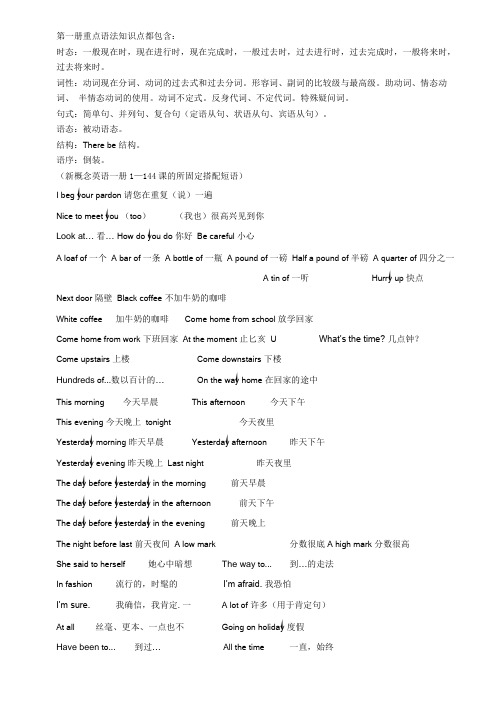
第一册重点语法知识点都包含:时态:一般现在时,现在进行时,现在完成时,一般过去时,过去进行时,过去完成时,一般将来时,过去将来时。
词性:动词现在分词、动词的过去式和过去分词。
形容词、副词的比较级与最高级。
助动词、情态动词、半情态动词的使用。
动词不定式。
反身代词、不定代词。
特殊疑问词。
句式:简单句、并列句、复合句(定语从句、状语从句、宾语从句)。
语态:被动语态。
结构:There be结构。
语序:倒装。
(新概念英语一册1—144课的所固定搭配短语)I beg your pardon 请您在重复(说)一遍Nice to meet you (too)(我也)很高兴见到你Look at… 看… How do you do 你好Be careful 小心A loaf of 一个 A bar of 一条 A bottle of 一瓶 A pound of 一磅Half a pound of 半磅 A quarter of 四分之一A tin of 一听Hurry up 快点Next door 隔壁Black coffee 不加牛奶的咖啡White coffee 加牛奶的咖啡Come home from school放学回家Come home from work 下班回家At the moment 止匕亥U What’s the time? 几点钟?Come upstairs 上楼Come downstairs 下楼Hundreds of...数以百计的…On the way home 在回家的途中This morning 今天早晨This afternoon 今天下午This evening 今天晚上tonight 今天夜里Yesterday morning 昨天早晨Yesterday afternoon 昨天下午Yesterday evening 昨天晚上Last night 昨天夜里The day before yesterday in the morning 前天早晨The day before yesterday in the afternoon 前天下午The day before yesterday in the evening 前天晚上The night before last 前天夜间 A low mark 分数很底A high mark 分数很高She said to herself 她心中暗想The way to... 到…的走法In fashion 流行的,时髦的I’m afraid. 我恐怕I’m sure.我确信,我肯定.一 A lot of 许多(用于肯定句)At all 丝毫、更本、一点也不Going on holiday 度假Have been to... 到过…All the time 一直,始终Have been to…到过…Drive into…撞倒.•・For sale 供出售、出售Have the last word 最后决定、最后才算The R.A.F. 英国皇家空军Return ticket 往返票Next door to... 与..•相邻,在..•隔壁In five hours’time在五小时之后。
新概念一册语法知识点

新概念一册语法知识点备注:1.主格通常放在句子最前面 e.g: We are friends.2.宾格放在动词或介词后面e.g: Tell me please.(tell是动词) This book is for him.(for是介词)3.4.5.形代+L3-41234L5-6:1.a/an(2.用L7-8:口诀:beI amThe bookit is=it’sL9-10:adj形容词的用法1.adj常与be动词搭配 e.g: It is hot.2.adj常修饰名词n. e.g: I am a beautiful girl.(beautiful修饰girl)L11-12:一、名词所有格:表示某个人的......用法:1.在名词词尾加上’s(有生命的)the boy’s bag2.以s结尾的复数名词,直接加’ teachers’ day3.不以s结尾的复数名词,加上’s children’s day4.A+B’s=共同拥有(后面的名词可单可复)Annie and Lily’s room/rooms.A’s+B’s=分别拥有(后面名词用复数)Annie’s and Lily’s rooms.二、特殊疑问词:7W1H三、对划线部分提问(特殊疑问句):想、找、抄、变L151.2.(1(2(3(4(5L171.man-men woman-women child-children mouse-mice tooth-teeth foot-feet Chinese-Chinese Japanese-Japanese sheep-sheep fish-fish deer-deer2.单数句变复数句秘诀:主语变复数,be改为are, 名词变复数,去掉a/anI am a teacher. We are teachers.L19-20:there be 句型表示某地有某物单数句There is a dog in the park.复数句There are some dogs in the park.变否定:be后加not There is not(isn’t) a dog in the park.There are not(aren’t) any dogs in the park.变疑问:be提前Is there a dog in the park? Are there any dogs in the park?备注:1.there be遵循就近原则There is a teacher and 10 students in the classroom.There are 10 students and a teacher in the classroom.2.不可数名词使用单数。
新概念英语第一册所有语法点汇总)
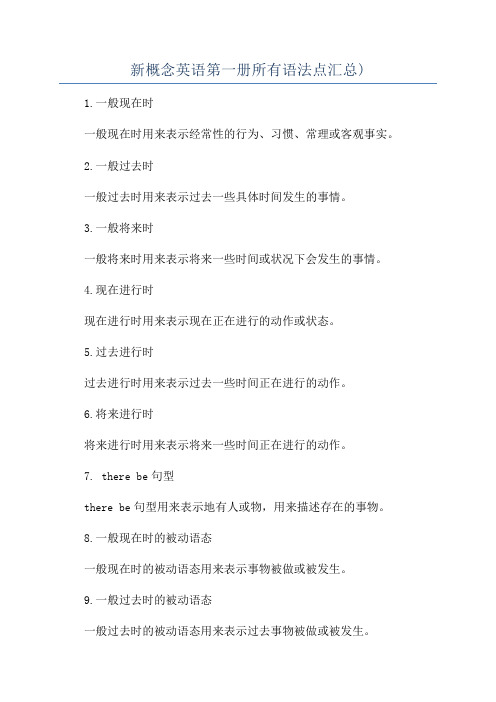
新概念英语第一册所有语法点汇总)1.一般现在时一般现在时用来表示经常性的行为、习惯、常理或客观事实。
2.一般过去时一般过去时用来表示过去一些具体时间发生的事情。
3.一般将来时一般将来时用来表示将来一些时间或状况下会发生的事情。
4.现在进行时现在进行时用来表示现在正在进行的动作或状态。
5.过去进行时过去进行时用来表示过去一些时间正在进行的动作。
6.将来进行时将来进行时用来表示将来一些时间正在进行的动作。
7. there be句型there be句型用来表示地有人或物,用来描述存在的事物。
8.一般现在时的被动语态一般现在时的被动语态用来表示事物被做或被发生。
9.一般过去时的被动语态一般过去时的被动语态用来表示过去事物被做或被发生。
10.一般将来时的被动语态一般将来时的被动语态用来表示将来事物将被做或被发生。
11.现在进行时的被动语态现在进行时的被动语态用来表示事物正在被做或被发生。
12.过去进行时的被动语态过去进行时的被动语态用来表示过去事物正在被做或被发生。
13. do与does的用法do和does用来构成否定句、疑问句和回答。
14.现在完成时现在完成时用来表示过去发生的动作对现在造成的影响或结果。
15.现在完成进行时现在完成进行时用来表示从过去开始一直延续到现在的动作,且这个动作可能还会继续下去。
16.过去完成时过去完成时用来表示过去在一些时间或事件之前已经完成的动作。
17.过去完成进行时过去完成进行时用来表示过去一些时间持续进行的动作,这个动作在另一个过去时间之前已经结束。
18.表示数量的词表示数量的词包括数词、基数词、序数词、分数和百分数等。
19.表示频率的词表示频率的词用来描述件事情发生的频率,如常常、经常、有时、很少、从不等。
20.表示时间的词表示时间的词用来描述一些事件发生的时间,如年、月、日、星期、时、分、秒等。
21.表示地点的词表示地点的词用来描述一些事件发生的地点,如国家、城市、街道、大楼等。
新概念英语第一册知识点总结
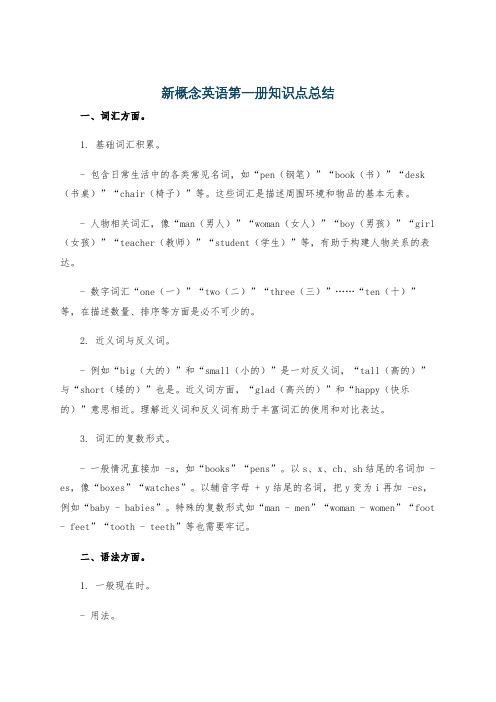
新概念英语第一册知识点总结一、词汇方面。
1. 基础词汇积累。
- 包含日常生活中的各类常见名词,如“pen(钢笔)”“book(书)”“desk (书桌)”“chair(椅子)”等。
这些词汇是描述周围环境和物品的基本元素。
- 人物相关词汇,像“man(男人)”“woman(女人)”“boy(男孩)”“girl (女孩)”“teacher(教师)”“student(学生)”等,有助于构建人物关系的表达。
- 数字词汇“one(一)”“two(二)”“three(三)”……“ten(十)”等,在描述数量、排序等方面是必不可少的。
2. 近义词与反义词。
- 例如“big(大的)”和“small(小的)”是一对反义词,“tall(高的)”与“short(矮的)”也是。
近义词方面,“glad(高兴的)”和“happy(快乐的)”意思相近。
理解近义词和反义词有助于丰富词汇的使用和对比表达。
3. 词汇的复数形式。
- 一般情况直接加 -s,如“books”“pens”。
以s、x、ch、sh结尾的名词加 -es,像“boxes”“watches”。
以辅音字母 + y结尾的名词,把y变为i再加 -es,例如“baby - babies”。
特殊的复数形式如“man - men”“woman - women”“foot - feet”“tooth - teeth”等也需要牢记。
二、语法方面。
1. 一般现在时。
- 用法。
- 表示经常或习惯性的动作或状态。
例如:I get up at six every day.(我每天六点起床。
)- 表示客观事实或真理。
The earth goes around the sun.(地球绕着太阳转。
)- 句子结构。
- 主语为第三人称单数(he/she/it等)时,动词要加 -s或 -es。
如:He likes reading.(他喜欢阅读。
)- 主语为第一人称(I)、第二人称(you)以及复数主语(we/they等)时,动词用原形。
最全的新概念英语第一册语法汇总
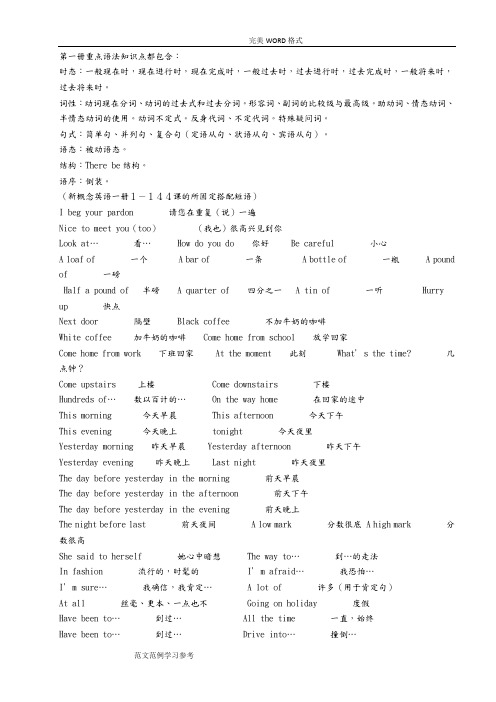
第一册重点语法知识点都包含:时态:一般现在时,现在进行时,现在完成时,一般过去时,过去进行时,过去完成时,一般将来时,过去将来时。
词性:动词现在分词、动词的过去式和过去分词。
形容词、副词的比较级与最高级。
助动词、情态动词、半情态动词的使用。
动词不定式。
反身代词、不定代词。
特殊疑问词。
句式:简单句、并列句、复合句(定语从句、状语从句、宾语从句)。
语态:被动语态。
结构:There be结构。
语序:倒装。
(新概念英语一册1-144课的所固定搭配短语)I beg your pardon 请您在重复(说)一遍Nice to meet you(too)(我也)很高兴见到你Look at…看… How do you do 你好 Be careful 小心A loaf of 一个 A bar of 一条 A bottle of 一瓶 A pound of 一磅Half a pound of 半磅 A quarter of 四分之一 A tin of 一听 Hurry up 快点Next door 隔壁 Black coffee 不加牛奶的咖啡White coffee 加牛奶的咖啡 Come home from school 放学回家Come home from work 下班回家 At the moment 此刻What’s the time?几点钟?Come upstairs 上楼 Come downstairs 下楼Hundreds of…数以百计的… On the way home 在回家的途中This morning 今天早晨 This afternoon 今天下午This evening 今天晚上 tonight 今天夜里Yesterday morning 昨天早晨 Yesterday afternoon 昨天下午Yesterday evening 昨天晚上 Last night 昨天夜里The day before yesterday in the morning 前天早晨The day before yesterday in the afternoon 前天下午The day before yesterday in the evening 前天晚上The night before last 前天夜间 A low mark 分数很底 A high mark 分数很高She said to herself 她心中暗想The way to…到…的走法In fashion 流行的,时髦的I’m afraid…我恐怕…I’m sure…我确信,我肯定… A lot of 许多(用于肯定句)At all 丝毫、更本、一点也不 Going on holiday 度假Have been to…到过… All the time 一直,始终Have been to…到过… Drive into…撞倒…For sale 供出售、出售 Have the last word 最后决定、最后才算The R.A.F. 英国皇家空军 Return ticket 往返票Next door to…与…相邻,在…隔壁In five hours’time在五小时之后。
新概念第一册语法知识点汇总(完美版)
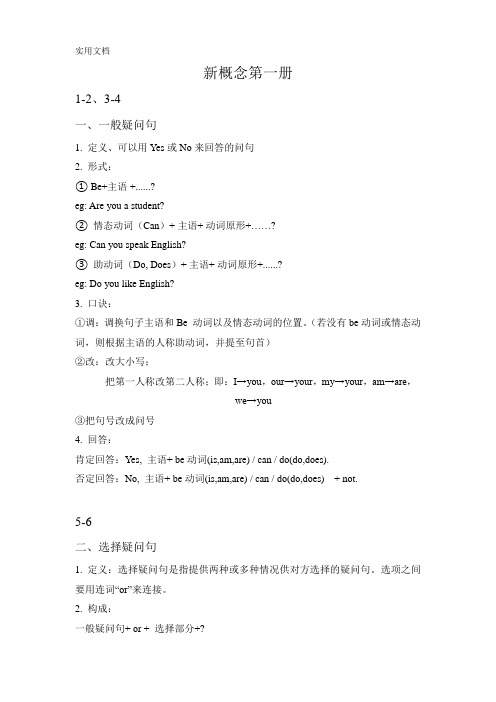
新概念第一册1-2、3-4一、一般疑问句1. 定义、可以用Yes或No来回答的问句2. 形式:① Be+主语 +......?eg: Are you a student?②情态动词(Can)+ 主语+ 动词原形+……?eg: Can you speak English?③助动词(Do, Does)+ 主语+ 动词原形+......?eg: Do you like English?3. 口诀:①调:调换句子主语和Be 动词以及情态动词的位置。
(若没有be动词或情态动词,则根据主语的人称助动词,并提至句首)②改:改大小写;把第一人称改第二人称;即:I→you,our→your,my→your,am→are,we→you③把句号改成问号4. 回答:肯定回答:Yes, 主语+ be动词(is,am,are) / can / do(do,does).否定回答:No, 主语+ be动词(is,am,are) / can / do(do,does) + not.5-6二、选择疑问句1. 定义:选择疑问句是指提供两种或多种情况供对方选择的疑问句。
选项之间要用连词“or”来连接。
2. 构成:一般疑问句+ or + 选择部分+?例:Are you a doctor or a teacher? 你是一个医生还是教师?Does he like this or that? 他喜欢这个还是喜欢那个?Is that coffee yours or hers? 这咖啡是你的还是她的?注:有时候选择部分会用“or not”来表示例:Are you ready or not (ready) ? 你准备好没有?Do you like the film or not? 你喜不喜欢这部电影?7-8、11-12、13-14三、特殊疑问句1. 含义:以特殊疑问词开头的疑问句。
2. 构成:特殊疑问词+一般疑问句+?3. 特殊疑问词总结:(1) what 什么(职业,姓名等)what day 星期几What day is it today? 几天星期几?what size 多大尺码What size are your shoes? 你的鞋码多大?what time 什么时间What time is it now? 现在几点了?what colour 什么颜色What color is your schoolbag? 你的书包是什么颜色?(2) when 什么时候(就时间提问)When will you visit Beijing? 你什么时候去北京玩?(3) where 什么地方(就地点提问)Where is your hometown? 你的家乡在哪?(4) who 谁(问人的身份,姓名等)Who is the girl in red dress? 穿着红裙子的女生是谁?(5) whose 谁的(whose + n.)Whose book is this?这是谁的书?(6) which 哪一个;哪些Which one is your sister ? 哪一个是你姐姐?(7) why 为什么(就原因提问,常用because回答)Why did you break the window?你为什么要打破窗户?(8) how 怎么样How do you go to school? 你怎么去学校?how many多少(提问可数名词数量)How many books do you have ?你有几本书?how much 多少(提问不可数名词数量)How much water is there in the glass?玻璃杯里有多少水?how much 多少钱(提问价格)How much is the ruler? 这把尺子多少钱?how old 几岁(提问年龄)How old are you? 你多少岁了?how long 多长(提问长度)How long is this ruler? 这把尺子有多长?多长时间(时间持续多久)How long do you go to school? 你去学校要多长时间?how often 多久一次(提问频率既单位时间发生多少次)how soon (还要多久时间才能开始或结束)How soon will he come back? 他多久才能回来?how heavy(提问有多重)How heavy is the luggage?这个行李箱有多重?9-10四、祈使句1. 定义:用于表达命令、请求、劝告、警告等的句子叫做祈使句。
新概念英语1A知识点总结

新概念英语1A知识点总结《新概念英语》是一套以提高英语学习者语法和词汇运用能力为目标的经典教材。
下面是《新概念英语》第一册1A的知识点总结。
1. be 动词- be动词有三种形式:am, is, are- be动词用于现在时,表示主语的状态、职业、身份、国籍、地点等。
- be动词用于过去时,有三种形式:was(用于第一、三人称)、were(用于第二人称和复数形式)2.句子的基本结构-英语句子的基本结构是主语+谓语+宾语,主语一般在句首,谓语一般在主语之后,宾语一般在谓语之后。
- 英语句子的一般疑问句句式是:Be动词+主语+其他成分,回答时可以用Yes/No答语或者提供具体信息。
3.冠词- a/an是不定冠词,a用于以辅音音素开头的单词前,an用于以元音音素开头的单词前。
- the是定冠词,特指其中一特定的人或事物。
4.复数名词-一般情况下,名词加s表示复数形式。
- 以s、x、sh、ch结尾的名词,加es表示复数形式。
- 以辅音字母+y结尾的名词,变y为i,再加es表示复数形式。
5.句子成分-主语通常是名词、代词或者动词不定式的完成式。
-宾语通常是名词、代词或者动词不定式的完成式。
-定语是修饰名词或者代词的词或者词组。
-状语是修饰动词、形容词或者副词的词或者词组。
6.指示代词- this指代较近距离的单数名词,these指代较近距离的复数名词。
- that指代较远距离的单数名词,those指代较远距离的复数名词。
7.物主代词- 单数第一人称物主代词是my,第二人称物主代词是your,第三人称物主代词是his/her/its。
- 复数第一人称物主代词是our,第二人称物主代词是your,第三人称物主代词是their。
8.介词-介词用于连接名词或代词与其他成分,表示方向、位置、时间、原因、方式等关系。
- 一些常用的介词包括:in, on, under, beside, at, before, after, from, to, with, of等。
(完整版)最全新概念英语第一册语法汇总,文档

时态:大凡现在时,现在进行时,现在完成时,大凡过去时,过去进行时,过去完成时,大凡将来时,过去将来时。
性:在分、的去式和去分。
形容、副的比与最高。
助、情、半情的使用。
不定式。
反身代、不定代。
分外疑。
句式:句、并列句、复合句〔定从句、状从句、从句〕。
:被。
构: There be构。
序:倒装。
〔新看法英一册1-144的所不搭配短〕I beg your pardon 您在重复〔〕一遍Nice to meet you〔too〕〔我也〕很高到你Look at 看⋯⋯ How do you do你好 Be careful小心A loaf of 一个 A bar of 一条 A bottle of 一瓶 A pound of 一磅 Half a pound of 半磅 A quarter of 四分之一 A tin of 一听 Hurry up 快点 Next door 近邻 Black coffee 不加牛奶的咖啡White coffee 加牛奶的咖啡 Come home from school 放学回家Come home from work 下班回家 At the moment 现在 What’ s the time?几点? Come upstairs上楼 Come downstairs下楼Hundreds of 数⋯以百的⋯ On the way home在回家的途中This morning 今天清早 This afternoon 今天下午This evening今天夜晚 tonight 今天夜里Yesterday morning 昨天清早 Yesterday afternoon 昨天下午Yesterday evening昨天夜晚 Last night 昨天夜里The day before yesterday in the morning前天清早The day before yesterday in the afternoon 前天下午The day before yesterday in the evening前天夜晚The night before last 前天夜 A low mark 分数很底 A high mark 分数很高She said to herself她心中暗想 The way to 到⋯⋯的走法In fashion 流行的,髦的I ’ m afraid我恐⋯怕⋯I ’ m sure我⋯确信,我必然⋯ A lot of多〔用于必然句〕At all 毫、更本、一点也不Going on holiday 度假Have been to 到⋯⋯ All the time素来,始Have been to 到⋯⋯ Drive into 撞倒⋯⋯For sale 供销售、销售 Have the last word 最后决定、最后才算英.国皇家空Return ticket 往返票Next door to与⋯相,在⋯近邻In five hours’在time五小此后。
新概念第一册语法知识点汇总(完美版)

新概念第一册1-2、3-4一、一般疑问句1. 定义、可以用Yes或No来回答的问句2. 形式:① Be+主语 +......?eg: Are you a student?②情态动词(Can)+ 主语+ 动词原形+……?eg: Can you speak English?③助动词(Do, Does)+ 主语+ 动词原形+......?eg: Do you like English?3. 口诀:①调:调换句子主语和Be 动词以及情态动词的位置。
(若没有be动词或情态动词,则根据主语的人称助动词,并提至句首)②改:改大小写;把第一人称改第二人称;即:I→you,our→your,my→your,am→are,we→you③把句号改成问号4. 回答:肯定回答:Yes, 主语+ be动词(is,am,are) / can / do(do,does).否定回答:No, 主语+ be动词(is,am,are) / can / do(do,does) + not.5-6二、选择疑问句1. 定义:选择疑问句是指提供两种或多种情况供对方选择的疑问句。
选项之间要用连词“or”来连接。
2. 构成:一般疑问句+ or + 选择部分+?例:Are you a doctor or a teacher? 你是一个医生还是教师?Does he like this or that? 他喜欢这个还是喜欢那个?Is that coffee yours or hers? 这咖啡是你的还是她的?注:有时候选择部分会用“or not”来表示例:Are you ready or not (ready) ? 你准备好没有?Do you like the film or not? 你喜不喜欢这部电影?7-8、11-12、13-14三、特殊疑问句1. 含义:以特殊疑问词开头的疑问句。
2. 构成:特殊疑问词+一般疑问句+?3. 特殊疑问词总结:(1) what 什么(职业,姓名等)what day 星期几What day is it today? 几天星期几?what size 多大尺码What size are your shoes? 你的鞋码多大?what time 什么时间What time is it now? 现在几点了?what colour 什么颜色What color is your schoolbag? 你的书包是什么颜色?(2) when 什么时候(就时间提问)When will you visit Beijing? 你什么时候去北京玩?(3) where 什么地方(就地点提问)Where is your hometown? 你的家乡在哪?(4) who 谁(问人的身份,姓名等)Who is the girl in red dress? 穿着红裙子的女生是谁?(5) whose 谁的(whose + n.)Whose book is this?这是谁的书?(6) which 哪一个;哪些Which one is your sister ? 哪一个是你姐姐?(7) why 为什么(就原因提问,常用because回答)Why did you break the window?你为什么要打破窗户?(8) how 怎么样How do you go to school? 你怎么去学校?how many多少(提问可数名词数量)How many books do you have ?你有几本书?how much 多少(提问不可数名词数量)How much water is there in the glass?玻璃杯里有多少水?how much 多少钱(提问价格)How much is the ruler? 这把尺子多少钱?how old 几岁(提问年龄)How old are you? 你多少岁了?how long 多长(提问长度)How long is this ruler? 这把尺子有多长?多长时间(时间持续多久)How long do you go to school? 你去学校要多长时间?how often 多久一次(提问频率既单位时间发生多少次)how soon (还要多久时间才能开始或结束)How soon will he come back? 他多久才能回来?how heavy(提问有多重)How heavy is the luggage?这个行李箱有多重?9-10四、祈使句1. 定义:用于表达命令、请求、劝告、警告等的句子叫做祈使句。
(完整版)新概念英语1A知识点总结
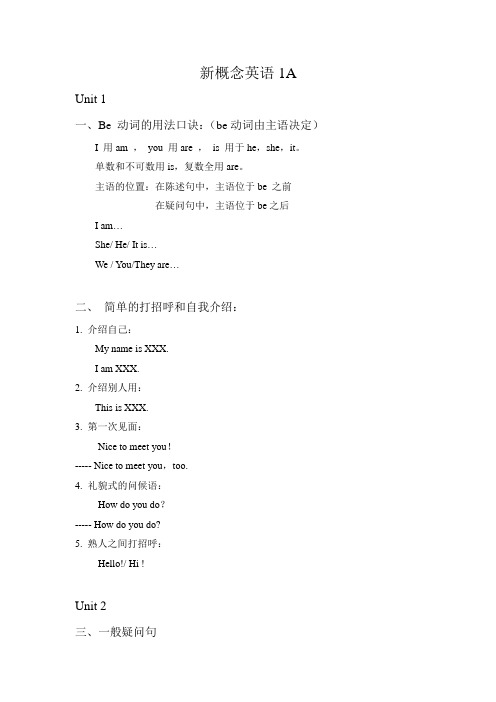
新概念英语1A Unit 1一、Be 动词的用法口诀:(be动词由主语决定)I 用am ,you 用are ,is 用于he,she,it。
单数和不可数用is,复数全用are。
主语的位置:在陈述句中,主语位于be 之前在疑问句中,主语位于be之后I am…She/ He/ It is…We / You/They are…二、简单的打招呼和自我介绍:1. 介绍自己:My name is XXX.I am XXX.2. 介绍别人用:This is XXX.3. 第一次见面:Nice to meet you!----- Nice to meet you,too.4. 礼貌式的问候语:How do you do?----- How do you do?5. 熟人之间打招呼:Hello!/ Hi !Unit 2三、一般疑问句1. 定义(什么叫做一般疑问句):可以用Yes或No来回答的问句。
2. 陈述句变一般疑问句步骤(怎么变?):①调:调换主语与be 的位置到句首。
②改:A:改写大小。
B:该人称:I(我)→you(你),we(我们)→you(你们),my (我的)→your(你的),am(用于I)→are(用于you等复数人称)C:将句号“.”改成问号“?”3. 回答:①肯定回答:Yes,主语+be.②否定回答:No,主语+be+not. (am与not不缩写)例:陈述句:This is my pen. 这是我的钢笔。
一般疑问句:Is this your pen? 这是你的钢笔吗?肯定回答:Yes, it is. 是的,这是我的钢笔。
否定回答:No, it is not(isn’t). 不,这不是我的钢笔。
4. Be动词的否定式:①:Be 的现在式:am , is , are②:Be 的过去式:was ,were③:否定式:is not= isn’t , are not=aren’t , am not无缩写形式四、冠词a/ an 的用法1. a + 以辅音发音开头的单词例:a hat , a man , a university [ˌju:nɪˈvɜ:səti]an + 以元音发音开头的单词例:an apple [ˈæpl] ,an orange [ˈɒrɪndʒ],an egg [eg],an uncle [ˈʌŋkl],an hour [ˈaʊə(r)]2. 单个字母出现在“Mr Li has one fox”中任何一个字母均用an例:an M an H an SUnit 3五、特问词的运用1. 特问词:What 问物(什么)How old 问年龄(多少岁)Who 问人(谁)How many/ much…?多少…?Whose 问谁的How 怎样What colour 问颜色Where 问哪里Which 哪一个(选择)When 问时间(什么时候)=what time2.例子① What is this?(问物)---- It is a bicycle. It is a silver bicycle.② Whose is this umbrella ?(问谁的)---- It’s William’s.③ What colour is Robert’s bicycle? (问颜色+问谁的)---- Robert’s bicycle is silver.六、对划线部分提问的做题技巧1. 选特问词。
- 1、下载文档前请自行甄别文档内容的完整性,平台不提供额外的编辑、内容补充、找答案等附加服务。
- 2、"仅部分预览"的文档,不可在线预览部分如存在完整性等问题,可反馈申请退款(可完整预览的文档不适用该条件!)。
- 3、如文档侵犯您的权益,请联系客服反馈,我们会尽快为您处理(人工客服工作时间:9:00-18:30)。
In the eve ning
At noon中午
At night夜里
At the mome nt
What's the time?
Come upstairs
Come dow nstairs
Hun dreds of…
On the way home
This morni ng
Would you like…? 你愿意…?
Could you…?
你能…?(比Can you…?更婉转客气)
Buy…on instalments
以分期付款的方式购买…
Small cha nge
零钱
Go back to sleep
继续睡觉
To take…with…
把…带上(with后跟人称宾格)
Have to
At all丝毫、
更本、一点也不
Going on holiday
度假
Have bee n to…
-到过…
All the time
一直,始终
Have bee n to…
-到过…
For sale
供出售、出售
Drive into
撞倒…
Have the last word最后决定、最后才算
The RAF.
英国皇家空军
Make up…minds打定主意(up后跟人称宾格)
Look after照看
In the end最后
In the first in sta nee首先,起初
He may be…他可能是…
I'm ot sure
我不敢肯定
I won der why
我想知道为什么
A long time (ago)
很早(前)
结构:There be
结构。
语序:倒装。
(请您记住以下新概念央语 册1-
-14 4课的所固定搭配短语)
英文中文
I beg your pardon
i请您在重复(说)一遍
Nice to meet you
(too)
(我也)很高兴见到你
Look at…
看…
How do you do
你好
Be careful
小心
二月
三月
四月
五月
六月
七月
八月
九月
十月
十一月
十二月
星期一
星期二
星期三
星期四
星期五
星期六
星期日
周未
(请记住以下特殊疑问句的特殊疑问词)
1、
Why
(有关原因)
2、
What
(有关事物)
3、
Which
(有关事物)
4、
Who
(有关人物)
5、
Whose
(有关人物)
6、
Where
(有关地点)
The ni ght before last前天夜间
A low mark
分数很底
A high mark
分数很高
She said to herself
她心中暗想
The way to…
至U…的走法
In fashi on
流行的,时髦的
I'm afraid…
我恐怕…
I m sure…
我确信,我冃疋…
A lot of许多(用于肯定句)
昨天晚上
Last ni ght
昨天夜里
The day before yesterday in the morning
前天早晨
The day before yesterday in the after noon
前天下午
The day before yesterday in the eve ning
前天晚上
Get married
结婚
Depe nd on…
依靠,取决于…
I'm late for
…我因为…而迟到
By the way
顺便(问,说)
I'm dressed in
… 我穿戴着…
Make up her face
往她的脸上施脂粉
Make myselft beautiful把自己打扮漂亮
Was covered with
不得不(过去式Had to)
By myself
我自己
By yourself
你自己
By himself
他自己
By herself
她自己
By itself它自己
By ourselves
我们自己
By yourselves
你们自己
By themselves
他/她/它们自己
By on eself
独自的
Not that long ago
…覆盖着…
I went for…
(…表明目的)
Pice of paper
纸片
Cigarette ends
烟头
Take out
拿出
成百上千的…
Round the world
周游世界
季节、月份、星期
Spring春节
Summer
夏天
Autu mn秋天
冬天
一月
第一册重点语法知识点都包含: 时态:一般现在时,现在进行时,现在完成时,一般过去时,过去进行时, 过去完成时,一般将来时,过去将来时。
词性:动词现在分词、动词的过去式和过去分词。形容词、副词的比较级 与最高级。助动词、情态动词、半情态动词的使用。动词不定式。反身代 词、不定代词。特殊疑问词。
简单句、并列句、复合句(定语从句、状语从句、宾语从句)。
A loaf of
一个
A bar of
一条
A bottle of
一瓶
A pound of
一磅
Half a pound of
半磅
语态:
被动语态。
A quarter of
A tin of
Hurry up Next door
一听
快点
隔壁
Black coffee
White coffee
In the morni ng
Retur n ticket
往返票
Next door to
…与…相邻,在…隔壁
In five hours
time在五小时之后。
Go back
返回
The othe day
几天前
Fell dow nstairs
从楼上摔下来
The Y .H.A.
青年招待所协会
Cheer up
振作起来
Full of…
充满了…
This after noon
This eve ning
不加牛奶的咖啡
加牛奶的咖啡
放学回家
下班回家
早上
下午
晚上
此刻
几点钟?
上楼
下楼
数以百计的…
在回家的途中
今天早晨
今天下午
今天晚上
toni ght今天夜里
Y esterday mor ning
昨天早晨
Y esterday after noon昨天下午
Y esterday eve ning
没那么久
At…(以…的方式进行、做某事)
He can't be… 他不可能…
He must be
他冃疋是…
He can't have been…他那时不可能 …
He must have benn…他那时肯定是 …
Don't be so sure别那么肯定
He may…他可能…
He might…他可能…(没有He might…的程度强)
